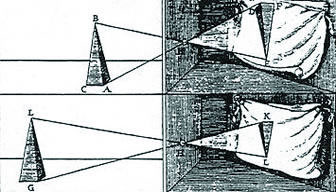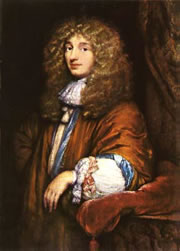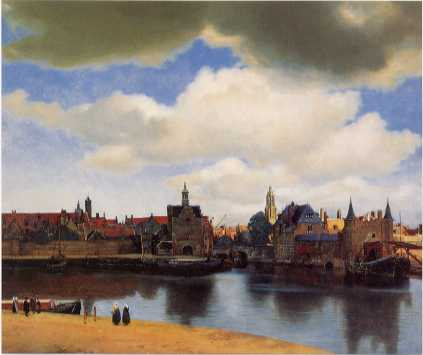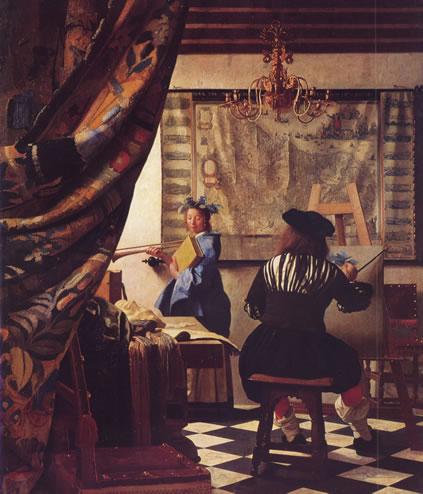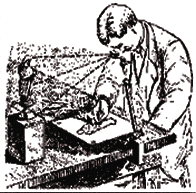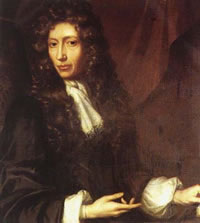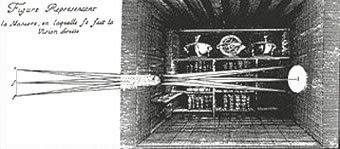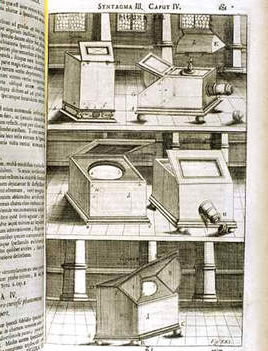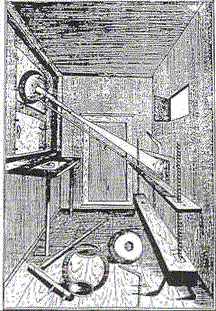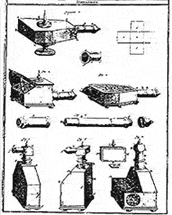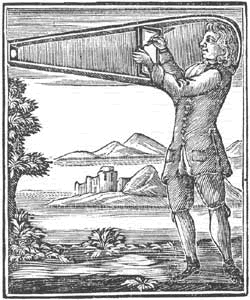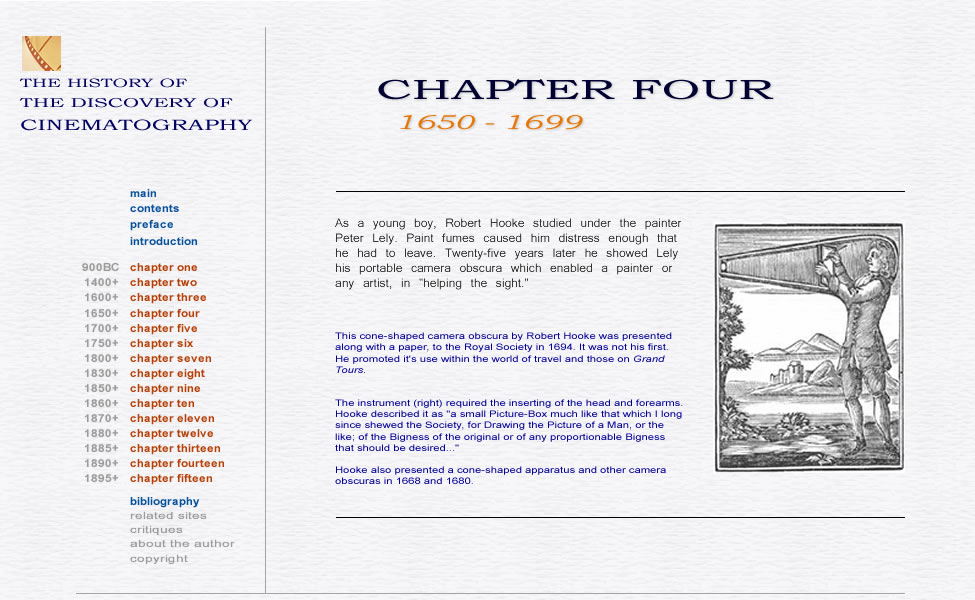 |
| |
|
|
|
| |
|
|
| |
1651 |
|
|
| |
The work of Leonardo Da
Vinci, namely his ‘Treatise on Painting', dealing with
optics, is published in Paris this year. |
|
| |
|
|
| |
|
|
|
| |
1651
MARTIN MARTINI (1614 - 1661) |
|
|
| |
This missionary and pupil
of Kircher's returned to Europe from the China mission in 1655 and for
the next four years will tour Europe lecturing extensively. Martini, alongside
of Andreas Tacquet and Kircher, will illustrate the new form of entertainment;
projected glass slides. Using Kircher's "Lanterna Magica", they will put
on a slide presentation of the trip to China. These lectures and presentations
are documented in Louvain (1654) and Leyden (1653). Interestingly enough,
a year after being ordained in 1629, Kircher had expressed to his superiors,
an interest in going to China. |
|
| |
|
|
| |
|
|
|
| |
|
|
| |
|
|
| |
1652
JEAN-FRANCOIS NICERON (1613 - 1646)
In
his 'La Perspective Curieuse' (Posthumously,
Niceron, J., Paris, France, 1652) Niceron gives a full description
of the camera obscura and it's use. Previous publications by Niceron
(1638 and 1646), who wrote on perspective, drawings, lenses and
mirrors, fail to mention the camera. Niceron told of charlatans
who used the image making process to cheat patrons out of their
purses. |
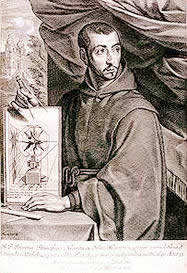 |
|
| From Niceron's
'La Perspective Curieuse' of 1652 (above). Niceron
wanted to show that image size had to do with the distance the
subject was from the lens. This illustration shows a room camera
with a hung drape or sheet, and the image in it's natural state
(inverted). The top half of the frame shows a subject closer to
the hole and a corresponding image. The bottom half shows the
object farther away and therefore proving a smaller image. |
| See
The Full Cover Page Of La Perspective Curieuse HERE See
the Frontispiece HERE |
| Jean-Francois
Niceron had his 'La Perspective Curieuse' (above
left) published after his death. In it, he talked of the use of
the camera image for evil purposes. His other works had failed
to include any mention of the phenomenon. Niceron was primarily
known for his work in perspectives and drawings. |
|
|
| |
|
|
| |
|
|
| |
|
|
|
| |
|
|
|
| |
1656
CHRISTIAN HUYGENS (1629 - 1695)
This Dutch physicist,
besides founding the undulating theory of light, discovering
the rings around saturn and stating the principle of centrifugal
force, is the maker of the oldest extant magic lantern we know
of.
In this year, Huygens wrote
to his brother Ludwig describing the lantern. Huygens introduced
and demonstrated the camera obscura to Dutch artists. |
|
|
|
|
| |
|
|
|
| |
|
|
| |
|
|
| |
|
|
|
| |
| 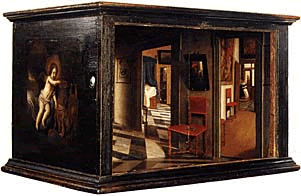
|
1656
SAMUEL VAN HOOGSTRAATEN (1627 - 1678)
Hoogstraaten successfully
attempted a three-dimensional exhibit in London. The show was
the interior of the great church at Haarlem. Hoogstraaten
was a Dutch maker of perspective boxes and other optical toys.
A superb
Hoogstraaten perspective box (left) c. 1660. Two individual
views from individual peepholes provided this 3-dimensional
view of a contemporary Dutch home. Five walls of the interior
'box' are painted with interior scenes of perspective while
the front wall is left open for light.
Light
once again comes into our story as it is this very light from
the open side that plays against the perspective artwork of
Hoogstraaten. He traveled all over Europe exhibiting his trompe
l'oeil-based peepshow boxes.
|
Samuel Van Hoogstraaten
was a student of Rembrandt and studied the writings of Da Vinci.
He attended a Dutch school of Trompe l'Oeil which is also a
term that means 'deceptive trickery', to 'fool
one's eye' and to 'deceive the sight'.
|
|
|
| |
|
Image
Source: The National Gallery, London |
|
| |
|
|
|
| |
|
|
| |
|
|
| |
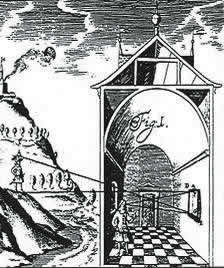 |
1657
GASPAR (CASPAR or KASPAR) SCHOTT (1608 - 1666)
Another
scholar and pupil of Kircher, Schott published his 'Magia
Universalis Naturae Et Artis' (Schott, K., Wurzburg,
1657) and describes a small camera obscura he was made aware
of (Part 1, "Magia Optica", Book 4, p200). Schott also
names every type of magic lantern and names Kircher as the inventor.
He also describes optical illusions using a rapidly revolving
wheel producing distorted figures (the Phantasmagoria
became popular in the late 18th century, as did Dissolving
Views and the Wheel of Life). On page
76 of his 'Magia Universalis' Schott used the
eye of an ox to compare with the retinal image. Schott will publish
his second edition of 'Magia Universalis' in 1674.
Here is one of Schott's camera obscura drawings (above)
from his 'Magia Universalis Naturae Et Artis'
(Wonders of Universal Nature And Art, 1657). This illustration
(left) is typical of a camera obscura in that it shows an image
from outside, the aperture in the wall of a room, the rays crossing
and the image lying on the wall. Perhaps as a bit of humour, Schott
portrays the viewer, as being the same as the statue being viewed
on the hill. |
|
|
| |
|
|
| |
|
|
| |
|
|
|
| |
|
|
|
| |
1658
THOMAS RASMUSSEN WALGENSTEN (1627 - 1681) |
|
|
| |
A professor of mathematics
at the university of Leyden, Walgensten begins to improve on the magic
lantern and show it throughout Europe, traveling widely. Now introduced
commercially, the magic lantern is presented as early as 1660 in Rome,
1662 in Paris, 1665 in Lyons, c.1670 again in Rome and in Copenhagen.
Both Kircher in his 'Ars Magna' (2nd Ed., 1671, pp768,9)
and De Chales Cursus Seu Mundus Mathematicus ( De
Chales, Claude Francois Milliet, 1690, Paris, France, 2nd Ed., vol.3,
p696) speak of the "learned Dane who came
to Lyons in 1665." Previous historians usually attribute Walgensten
as the "Dane" who Kircher and De
Chales spoke of. |
|
| |
|
|
|
| |
|
|
|
| |
|
|
| |
|
|
| |
| 1660
JAN (JOHANNES) VERMEER VAN DELFT (1632 - 1675)
It is highly possible
that this Dutch painter of the 17th century used the camera
obscura in some of his work. View
of Delft (1660, The Hague) is a likely product
of the camera's use as suggested by commentators and art historians
like Kees Kaldenbach.
His comments on
View of Delft and the 'circles of confusion' leave
us with little doubt that Vermeer used the camera....."If
the sun would hit and sparkle on the wet surface of this ship,
a view through a Camera Obscura would present fuzzy rings -
called circles of confusion - on the frosted glass. Oddly enough
Vermeer has copied this optical effect in a shaded area on the
side of the ship, outside direct sunlight, thus not in a logical
spot." -Kaldenbach
Without the use of the
camera, Vermeer would never have seen the effect of the rings.
This reproduction (right)
unfortunately cannot accurately show the effect. Vermeer's Girl
with a Red Hat also shows the rainbow ring effect.
|
|
| View
A Large Format Digitized Image Of The Painting Here |
Vermeer's
View Through A Camera, View of Delft by Jan Vermeer
(1632-1675), 1660 (Mauritshuis, The Hague) |
|
|
| |
|
|
| |
At the 2003 gathering
that studied the Hockney-Falco theory (Optics, Optical Instruments
And Painting: The Hockney-Falco Thesis Revisited ESF Exploratory Workshop,
12-15 November 2003, Ghent) based on David Hockney's 2001 book "Secret
Knowledge: Rediscovering The Lost Techniques Of The Old Masters"
which claims that master painters of the 16th & 17th centuries (late
thesis) used optics, namely concave mirrors, lenses and in particular
the camera obscura in their work, Philip Steadman of University College
London supported the theory. His contribution, Idealism, Realism,
and Vermeer's Use of the Camera Obscura, included the following; |
|
| |
|
|
| |
As
the domestic interiors of Vermeer are studied with ever greater attention,
more and more of the objects depicted - pieces of furniture, maps, globes,
'painted paintings' - turn out to be real objects, represented (for the
most part) with great fidelity, at their precise known sizes. On the evidence
of my own perspective analyses, as well as recent archival work by Warffemius,
it transpires that the room which provides the setting for as many as
ten of these pictures has the same dimensions and the same windows as
the first-floor studio which Vermeer occupied in his mother-in-law's house
from the late 1650s. The artist's two townscapes, the 'View of Delft'
and ''The Little Street' can be shown, I believe - contrary to the opinions
of some Vermeer scholars -to be slavishly faithful in detail to the appearances
of the actual scenes in question. In all these respects then, Vermeer
was a realist, who achieved this truth to appearances through his systematic
employment of the camera obscura. For some art historians, nevertheless,
this line of argument is repugnant, since for them it is at odds with
a Vermeer whose work lies in a tradition of idealised, conventionalised
Dutch genre subjects; whose two-dimensional compositions are not 'snapshots'
but meticulous constructions of carefully balanced shapes; and whose paintings
are scattered - although not so liberally as those of some contemporaries
- with emblematic allusions and iconographical meaning. All these points
are valid ones. I will argue that their validity is, however, perfectly
compatible with a camera technique. For Vermeer the camera obscura was
a 'composition machine' with which, working like a 19th century studio
photographer, he was able to design idealised, highly-considered, in some
instances even richly allegorical compositions, by the arrangement of
real objects in real rooms. -
Philip Steadman, Thursday November 13, 2003, Ghent |
|
| |
|
|
| |
Another view on Vermeer
comes to us from one Anson K. Cross who was a painter, teacher and writer
on the subject of art in the late 19th and early 20th centuries. The Cross
theory on Vermeer is fascinating and to describe it best he created a
camera obscura of his own. He called it 'Vermeer's Camera'.
Visit the Jack & Beverly Wilgus site The
Magic Mirror of Life for the complete theory from A. K. Cross, and,
photographs of the camera. |
|
| |
|
|
| |
|
|
| |
|
|
| |
|
|
|
| |
|
|
|
| |
1662
THOMAS RASMUSSEN WALGENSTEN (1627 - 1681) |
|
|
| |
The Frenchman Petit writes
in a letter to Christian Huygens information on the scare lantern
(Schreckenlaterne Lanterne De Peur) by Walgensten. This
apparatus will be detailed in an optical textbook titled 'Centuriae
Optical Pars Altera' in 1668 by Italian Francesco Eschinardi.
This could be the first mention of the term 'magic lantern'. |
|
| |
|
|
|
| |
|
|
|
| |
|
|
| |
|
|
|
| |
| 1663
CHRISTIAN HUYGENS (1629 - 1695)
Huygens introduces the
magic lantern into England. |
|
|
|
|
| |
|
|
| |
|
|
|
| |
|
|
|
| |
1663
JOHN REEVES ( - ) |
|
|
| |
The London optician John
Reeves, an acquaintance of Huygens, produced his own lanterns in England. |
|
| |
|
|
|
| |
|
|
|
| |
|
|
| |
|
|
| |
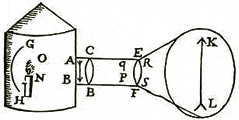 |
1665
THOMAS RASMUSSEN WALGENSTEN (1627 - 1681)
The
Dane travels widely throughout Europe and makes a stop in Lyons
France, presenting the magic lantern to audiences and had it illustrated
in De Chales 1674 'Cursus Mathematicus' (vol.2,
p666). |
| This
illustration (above) is Walgensten's magic lantern which
he presented when in Lyons in 1665. One candle provides the light
needed when accompanied by a reflecting mirror for added brilliance.
This lantern was included in De Chales 'Cursus Seu Mundus
Mathematicus' (De Chales, F., M., 1st edition) in
1674, 2nd volume, p666. |
|
|
| |
|
|
| |
|
|
| |
|
|
| |
|
|
| |
| 1666
JAN (JOHANNES) VERMEER VAN DELFT (1632 - 1675)
It is certain that Vermeer
used the camera obscura in his 1666 (1660-1673?) oil on canvas
entitled The Art of Painting.
As a student of illumination
in painting his objects and a keen knowledge of linear perspective,
Vermeer gave us what many believe is his best work.
In using the camera obscura
to prepare and 'line up' the people and objects within the room,
Vermeer was able to provide a realism to this and other works,
more than two hundred years before the discovery of photography.
As stated in the BBC Wales production The Private Life
Of A Masterpiece: The Art Of Painting (2005), "the
painting still speaks to modern filmmakers".
In using tack lines as did
builders and masons, Vermeer brought the vanishing point and
the viewers eye to just in front of the Muse of History, Clio.
Simple geometry for perfect perspective. In this high-res
image the original spot where the tack was placed by Vermeer,
can still be seen just below Clio's right hand, and the rod
holding the map. This same tack hole can be found in 17 of Vermeer's
paintings.
As filmmaker Peter Greenaway
states, "Vermeer was the world's
first cinematographer because he dealt in a world completely
manifest by light".
The Art Of Painting is the
nearest Vermeer could have got to a photo-graph simply because
it's a scale painting, of a camera obscura image. |
|
| View
A Large Format Digitized Image Of The Painting Here |
Another View Through
The Camera; Vermeer's The Art Of Painting.
Kunsthistorisches, Vienna. |
|
|
| |
|
|
| |
As Vermeer presented the
'circles of confusion' in View of Delft as seen through
the camera obscura, so did he present the natural blur of the drapery
on the table and the sharpness of the painter himself in perfect focus.
The camera obscura of course provides the same optical discrepancies in
scale, focus and blur. |
|
| |
By Vermeer's time, camera
obscuras were the most sophisticated and were portable making it easier
for artists to maneuver and set up. The lenses provided sharper and more
vivid images. |
|
| |
|
|
| |
|
|
| |
|
|
| |
|
|
|
| |
1666
ROBERT HOOKE (1635 - 1703) |
|
|
| |
This lecturer and later
scientist gave a talk at Gresham College on felt-making and in the middle
of it began describing what he would later call a camera lucida but which
in fact was a portable camera obscura (also SEE HOOKE
1668, HOOKE 1680, HOOKE
1694). The camera lucida began to be used as an instrument for making
drawings easier, and perspectively correct (also SEE
ALBERTI'S CAMERA LUCIDA). |
|
| |
|
|
|
| |
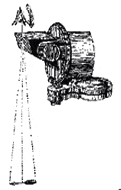 |
The Camera Lucida
was an offshoot discovery of the camera obscura. Useful as a drawing
aid to artists as opposed to the entertaining attraction of the
camera, the lucida was more portable. Lucida means 'light room'
referring to the need for light and that it must be used in the
daylight. In 1680 Hooke would present a paper to the Royal Society
where he would describe and present a cone-shaped camera lucida
which he called a lucida. This instrument of Hooke's greatly resembles
by description, the intersector of Alberti's. |
|
|
|
| |
|
|
| |
|
|
| |
|
|
|
| |
|
|
|
| |
1667
ROBERT BOYLE (1627 - 1691) |
|
|
| |
A founding member of the
Royal Society, Boyle in his 'Experiments And Considerations Upon
Colours' (Boyle, R., Geneva, Switzerland, 1667, ch.36)
mentions silver chloride turning dark "in
the air". |
|
| |
|
|
|
| |
|
|
|
| |
|
|
|
|
|
|
| |

|
1668
ROBERT HOOKE (1635 - 1703)
This English scientist
and part-time assistant to Boyle, reported to the Royal Society
in a paper (Phil. Trans. Royal Society, No.38, vol.3, 1668)
about a universal projection system and "a
contrivance to make the picture of anything appear on a wall,
in the midst of a light room in the daytime".
The use of mirrors
for magnification allowed the room to be lit. Hooke called this
a camera lucida. He would present two more papers to the Royal
Society, in 1680 and 1694.
Hooke would also use
ice as a burning glass, long since known.
|
| Robert
Hooke (above) Without His Wig |
|
|
|
| |
|
|
|
| |
|
|
|
| |
|
|
| |
|
|
| |
1669
ROBERT BOYLE (1627 - 1691)
Boyle
describes a "portable darkened room"
in his 'Of The Systematicall And Cosmical Qualities Of
Things" (Boyle, R., Oxford, England, 1669).
This was a portable box camera which he constructed, and then
described. He also talks of using oiled paper as a base and having
the viewer look through a hole to see the image. He claims this
camera obscura of his own, was shown years earlier (no trace of
this has been found in all of Boyle's known works). |
|
| |
Robert
Boyle (above) |
|
|
| |
|
|
| |
|
|
| |
|
|
|
| |
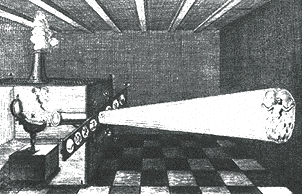 |
1671
ATHANASIUS KIRCHER (1602 - 1680)
Kircher
published his second, and expanded edition of 'Ars Magna'
and gives two illustrations of his lantern. On pages 768 and 769
Kircher names Walgensten as having a fine lantern, but still claims
the magic lantern as his own. He also described a revolving disk
similar to the rotating wheel of his 1646 edition. He referred
to this as a 'Smicroscopin'. The story of Christ's death, burial
and resurrection are depicted in eight separate slides, or scenes.
His illustration of the magic lantern in this edition (Amsterdam)
clearly show the direction of his thinking, when we see the possibility
of movement using successive slides. |
| Kircher's
revised Ars Magna of 1671 provides a wonderful
cut-out illustration (above left) of his magic lantern.
The drawing clearly shows the lens, mirror, light source (lamp),
slides and image on the wall. Kircher claimed he was the inventor.
The slides are offered in the inverted position in order to provide
an upright presentation. Notice the reflecting mirror for greater
illumination. |
|
|
| |
|
|
| |
|
|
| |
|
|
|
| |
1671
CHERUBIN D'ORLEANS (1613 - 1697)
In
his 'La Dioptrique Oculaire' (d'Orleans,
Cherubin, Capucin, Paris, France, 1671) D'Orleans gives an
illustration of a darkened room where alphabetical letters are
projected upside down.
An illustration (right) from the book 'La Dioptrique
Oculaire' of 1671 by Cherubin d'Orleans. D'Orlean's version
of a camera obscura showing the light rays and their inversion
at the aperture. |
|
|
|
| |
|
|
| |
|
|
| |
|
|
|
| |
|
|
|
| |
1672
JOHANN CHRISTOPH STURM (1635 - 1703) |
|
|
| |
Sturm introduces the magic
lantern into Germany where he was professor of mathematics at the University
of Nurnberg. Sturm gave experimental lectures on the lantern and spoke
of it in novelistic terms. Later in 1676 he would publish his 'Collegium
Experimentale Sive Curiosum' (Sturm, J., Nurnberg, Germany,
1676) and illustrates a portable camera obscura using a 45 degree-angled
mirror for drawing purposes (the reader will recall Benedetti in 1585
suggesting the same use of angled mirrors to upright the image, and also
Herigone in 1642 with his goblet). Sturm suggested the apparatus be large
enough to allow the head and hand of the artist to be inserted. |
|
| |
|
|
|
| |
|
|
|
| |
1673
CHRISTOPH ADOLPH BALDUIN (BALDEWEIN) (1623 - 1682) |
|
|
| |
This Saxon magistrate
and alchemist produced calcium nitrate, a luminous substance, by mixing
chalk and nitric acid, and published his findings in 'Miscellanea
Curiosa Medico-Physica Academiae' (Balduin, Christoph, Frankfurt
and Leipzig, Germany, 1673). He calls his find the "carrier
of light" and labels it
the much sought-after mystic "Philosopher's Stone". |
|
| |
|
|
|
| |
|
|
|
| |
|
|
| |
|
|
| |
1674
CLAUDE FRANCOIS MILLIET DE CHALES (1621 - 1678)
Well
versed in many sciences, this French mathematician, and professor
of humanities and hydrography at the University of Marseilles,
actually said he did not invent the magic lantern. He wrote two
editions of his monumental 'Cursus Seu Mundus Mathematicus'
(De Chales, F., M., 1st ed. 1674, 2nd ed. 1690, Paris, France)
where he improved on the already well known lantern by tackling
focus, focal point, better illumination and a sharper image. He
also illustrates (1st ed. 1674, vol.ii, p666) the lantern
of Walgensten in this book. De Chales also suggested the idea
of introducing glass slides from the side, and showing them in
succession. |
| |
| The 'motion' of
the magic lantern comes to life in this slide of German origin.
Four simple pictures from left to right tell the story of the
painter and the prankster. De Chales introduced the idea of successive
glass slides on a horizontal plain in 1674. See also Zahn 1685.
(Courtesy
The International Arts, Antiques and Collectibles Forum) |
|
|
| |
|
|
| |
|
|
| |
|
|
|
| |
|
|
|
| |
1674
GASPAR SCHOTT (1608 - 1666) |
|
|
| |
Schott's second edition
of his 'Magia Universalis' (see 1657, 1st ed.)
is published and in it he again describes all kinds of magic lanterns,
lenses, and burning glass lenses of Archimedes. |
|
| |
|
|
|
| |
|
|
|
| |
1677
J.C. KOHLANS ( - ) |
|
|
| |
Another camera obscura
is disguised, this time in the form of a book, by this German school teacher.
He called it his "Opticum Libellum" and published 'Neu-Erfundene
Mathematische Und Optische Curiostaten' in Leipzig in 1677. The
book is illustrated and described in figure 302. |
|
| |
|
|
|
|
|
|
|
| |
|
|
| |
|
|
| |
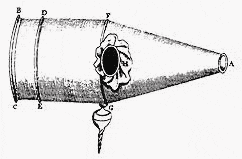 |
1680
ROBERT HOOKE (1635 - 1703)
Hooke
gave a lecture to the Royal Society (it's contents can be found
in Richard Waller's edition "Posthumous Works Of Robert
Hooke", (London, 1705, p127) in which he described
his cone-shaped camera obscura (the same instrument described
in his 1668 lecture, but called it a camera lucida [not to
be confused with the true lucida of Wollaston]. This camera
was about five feet in length and light entered through the apex.
The viewer looked through the centre hole of the device. |
| Hooke's
cone-shaped camera obscura (above) of 1680. His paper to
the Royal Society dealt with the eye, vision and light. The opening
of the cone (A) held the lens (convex). This shape of course placed
a curved image on the rear screen (BC). The section between BC
and DE was not fixed, in that BC could be moved inward allowing
a larger or smaller picture. In his study of the eye, Hooke imitates
the pupil by securing diaphragms at the lens to show expansion
and contraction. The opening at (H) is for looking in, to see
the image. The plumb-bob-looking thing at the bottom is believed
by some, to be a type of handle that the artist could use to point
the instrument, and to help support it (we believe it could have
been driven into a post or fence etc. as a means of anchoring
when out-of-doors). This is reminiscent of how photographers of
today prop up their telephoto lenses on tripods or other firm
foundations. |
|
|
| |
|
|
| |
|
|
| |
|
|
|
| |
1685
JOHANN ZAHN (1631 - 1707)
This
year, Zahn published in Wurzburg 'Oculus Artificialis Teledioptricus
Sive Telescopium' (Zahn, J., Wurzburg, 1685-6).
In this wondrous book, we find many descriptions and illustrations
of both the camera obscura and magic lantern. Zahn used the lantern
for anatomical lectures, illustrated a large workshop camera obscura
for solar observations using the telescope and scioptric ball, demonstrated
the use of mirrors and lenses to erect the image, enlarge and focus
it. Zahn also designed several portable camera obscuras for drawing
using the 45 degree mirror, and used side flaps to shield unwanted
light. Zahn's camera obscuras were the closest thing to what 19th
century cameras were. Zahn gave credit for the magic lantern to
Kircher and mentions Schott and De Chales in his references. Zahn
also suggested the presentation of images under water and proceeded
to explain, and stressed the importance of hiding the magic lantern
out of sight of the audience. This book also goes on to show how
time (a clock) can be projected onto a larger screen, and how wind
direction can be seen by having a connection from the lantern to
a wind vane on the roof of the building. Zahn even foresaw the use
of the lantern to project the image on glass which allowed several
to view at one time, as opposed to the camera obscura which was
limited largely to one observer at a time [excepting the room camera]
(as the kinetoscope surpassed the mutoscope for the same reason).
|
|
| The
page to the above right (from Zahn's 'Oculus Artificialis
Teledioptricus Sive Telescopium' of 1685) shows a drawing
by Johannes Zahn in the bottom frame, of a portable camera obscura
with side flaps in order to shield unwanted light from the viewer's
vision. It was considered portable not only because of it's size
but also it's ability to be moved easily from room to room. Notice
its roller-wheels. Zahn was a visionary in many ways. He suggested
the camera could be used underwater, projected on glass for multiple
use and, as a clock. |
|
|
| |
|
|
| |
Zahn's
camera obscuras were the closest thing to what 19th century cameras were.
Zahn gave credit for the magic lantern to Kircher and mentions Schott
and De Chales in his references. Zahn also suggested the presentation
of images under water and proceeded to explain, and stressed the importance
of hiding the magic lantern out of sight of the audience. This
book also goes on to show how time (a clock) can be projected onto a
large screen, and how wind direction can be seen by having a connection
from the lantern to a wind vane on the roof of the building. Zahn even
foresaw the use of the lantern to project the image on glass, which
allowed several to view at a time, as opposed to the camera obscura,
which was limited pretty well to one observer at a time (as the Kinetoscope
surpassed the Mutoscope for the same reason).
|
|
| |
|
|
| |
|
|
| |
|
|
| |
|
|
|
| |
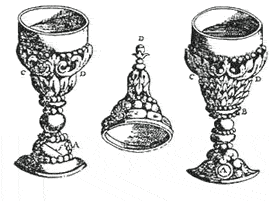 |
1685
JOHANN ZAHN (1631 - 1707)
In
his 'Oculus' Zahn gave us an illustration of
a very interesting camera obscura in the shape of a goblet. This
design was that of the French mathematician Pierre Herigone, in
1642. Herigone wrote 'Supplementum Cursus Mathematici'
and in chapter 6, page 113 he described his goblet camera obscura
but without any drawing or illustration.
The
goblet camera obscura design (left) of Pierre Herigone
(1642), and illustrated by Johannes Zahn in his 'Oculus
Artificialis Teledioptricus Sive Telescopium' (1685).
An ingenious device actually if you wanted to spy on others while
enjoying their company over a drink. The mirror (f ) was on a
45 degree angle in the base with a stylized opening for the lens
(A) so as not to create suspicion. The goblet had a cup (CD) made
of glass where the image could be seen. The lid (centre) had a
magnifying lens (D) at the top. This was likely a novelty with
little practical significance. One wonders what others would think
of a user with his eye so close to the cup or lid. |
|
|
| |
|
|
| |
|
|
| |
|
|
|
| |
| In
1685 Johann Zahn published his 'Oculus Artificialis Teledioptricus
Sive Telescopium'. In it he wrote on the use of the lantern to project
the image on glass, which allowed several to view at one time. This
lanternslide (right) depicts a winter scene and provides a strong
suggestion of movement. (Courtesy The
International Arts, Antiques and Collectibles Forum) |
|
|
|
| |
|
|
| |
|
|
| |
|
|
|
| |
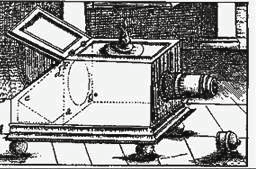 |
1685
JOHANN ZAHN (1631 - 1707)
Perhaps
the most prolific writer and illustrator of the camera obscura,
Zahn has left us with many different diagrams, illustrations and
sketches. The 5
entries found below are all from Zahn's 'Oculus'
of 1685 . . . .
1
One of his
reflex cameras (left) showing the interior with 45-degree mirror,
raised flap at rear, and an extended lens with the cap off. This
lens was really the same as used today. It could provide a clear
focus because it was housed within a cylindrical tube and was then
brought forward or back. Notice again, the wheels for ease of movement.
|
|
|
| |
|
|
|
| |
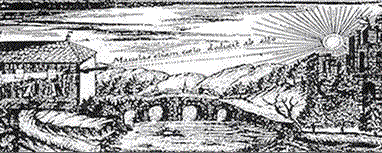 |
|
2
Zahn was a student of light as well as the eye and vision in general.
He studied the camera obscura effect as well as the magic lantern.
When speaking of the lantern, Zahn pays respect to Kircher when
he says; "the projection of images of objects
was announced in a wonderful manner by Kircher." The
drawing (above-left) shows the great interest Zahn had in
the ability to study light and in particular, the heavenly bodies.
The Latin words along the sun ray translates as.... "It
shows the dark spots from high heaven". Clearly we can
see the telescopic lens Zahn would use to provide a sharp upright
image.
3 The interior
shown (right) (again from 'Oculus') in this engraving could
very likely be the room illustrated in the picture left-above [2]
(or one similar). This camera obscura shows a telescope housed within
a scioptric ball (mounted on the upper left wall) but more importantly,
notice the attached steering-rod immediately underneath the telescope.
The rod was used to follow the movement of the sun throughout the
day thereby tracking it's movement. On the right wall can be seen
a bench supporting the screen, a long screw and bracket for adjustment.
An extremely bright and clearly focused image of the sun or landscape
could be seen through this method. On the floor we can see the scioptric
ball, telescope, adjusting bracket and lens. Johannes Zahn was a
visionary who was obviously ahead of his time when one considers
the many ideas, suggestions, inventions and various camera obscuras
and lanterns that he made. |
|
|
| |
|
|
|
| |
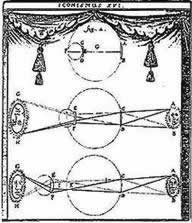 |
4
Here (right) we see a collection of portable camera obscuras
including a telescopic tube, which could house a telescopic lens.
In the centre example (long 3-piece) notice the smaller circumferenced
middle used for focusing by sliding the piece back or forth. Besides
illustrating the use of a biconvex lens to correct images, Zahn
also presented the effect produced from a telescopic lens (close-ups),
by inserting a negative lens. This allowed a larger image without
the use of a more cumbersome camera obscura frontal section (see
Brander 1769). Three of these telescopic cameras can be seen here
in the illustration to the left, from an extract of 'Oculus', 1685. |
|
| 5
Zahn shows us here (above) the variances in using different
lenses to enlarge the image (concave) or correct it (convex). One
interesting point we notice here is that on the white sheet or screen
that Zahn uses to make his illustration, we see that the 'curtain"
is up. Two draw-cords are clearly visible with the curtain bundled
at the top [reminiscent of the curtain going up at the cinema -
remember that Zahn also suggested hiding the lantern out of view
of the audience]. Taken from 'Oculus Artificialis Teledioptricus
Sive Telescopium', Wurzburg, 1685-1686. |
|
|
| |
|
|
| |
|
|
| |
|
|
|
|
|
|
|
| |
1687
MARCO ANTONIO CELLIO ( - ) |
|
|
| |
Cellio designed a portable
camera used for copying copperplate etchings, silhouettes and paintings. |
|
| |
|
|
|
| |
|
|
|
| |
1690
CLAUDE FRANCOIS MILLIET DE CHALES (1621 - 1678) |
|
|
| |
On page 696 of his second
edition of 'Cursus S. Mundus', (published after his death)
De Chales details his meeting with Walgensten in Lyons back in 1665. In
the section on optics, De Chales tells us he knew the retinal image is
reversed. He also attempted three-dimensional projection and improved
on the intersector of Alberti, by adding a mirror. De Chales spoke of
Witelo and Alhazen. |
|
| |
|
|
|
| |
|
|
|
| |
SOMETIME IN 1690 |
|
|
| |
The French poet and writer
Fenelon wrote what might be considered a non-fiction(?) fable on the effects
of nature's reflection when we read: "There was
no painter in that country; but if anybody wished to have the portrait
of a friend, of a picture, a beautiful landscape, or of any other object,
water was placed in great basins of gold or silver, and the object desired
to be painted was placed in front of that water. After a while the water
froze and became a glass mirror, on which an ineffaceable image remained."
Whether this is fiction or real we leave to the reader however,
consider SHOA ONG 121 B.C. and 1760 DE LA ROCHE. Also remember (see 40-96
A.D. PABLIUS PAPINIUS STATIUS) the poem 'The Hair of Earinus'
by Statius . . . "do you only fix your
glance upon it and leave your features here. Thus he spoke and showed
the mirror with the image caught therein."
The fable by Fenelon was entitled 'Une Voyage Suppose'. |
|
| |
|
|
|
| |
|
|
|
| |
|
|
| |
|
|
| |
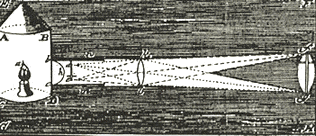 |
1690
WILLIAM MOLYNEUX (1656 - 1698)
A
professor at Trinity College in Dublin, Molyneux in his 'Dioptica
Nova' (Treatise on Dioptics, Molyneux, W., Dublin,
1692) which was published two years after it was written, devoted
a whole section to the magic lantern and the camera obscura. His
book also contained on the last page, an advertisement for such
things, from a London dealer. On page 181, table 38, figure 2, Molyneux
illustrates his lantern clearly showing a condensing lens, and described
the painted scenes as "frightful and ludicrous". A combination of
lenses were used to provide telescopic effects and a long throw.
Molyneux's work is very likely the first English account in scientific
terms of this art-science. |
| Molyneux's
magic lantern (above) of 1690, (published in 1692) from 'Dioptica
Nova' (Treatise on Dioptics, Molyneux, W., Dublin, fig2,
tab38, p181, 1692). This illustration shows a simple candle as the
source of illumination and a condensing lens. Notice the object
being projected is a cross, and is upside down in front of the lens
(h) in order to give an upright image, as opposed to the other way
around which was the norm in almost all other illustrations you
see of the magic lantern (excepting Cheselden and Kircher). |
|
|
| |
|
|
| |
|
|
| |
|
|
|
| |
|
|
|
| |
1693-1694
WILHELM HOMBERG (1652 - 1715) |
|
|
| |
This German chemist and
member of the Academie Royale Des Sciences in Paris conducted numerous
studies of light-sensitivity in some silver salts. He noticed that bone
dipped in silver nitrate would darken in sunlight, but he did not differentiate
it (the action of the sun's light) from the action of heat, as Schulze
did. He also discovered leuchtstein from lime and muriatric acid. |
|
| |
|
|
|
| |
|
|
|
|
|
|
| |
|
|
| |
|
|
| |
1694
ROBERT HOOKE (1635 - 1703)
Hooke
describes his "picture-box" in a paper to the Royal Society.
Dernham, in 1726 would compile Hooke's work in 'Philosophical
Experiments and Observations of the Late Eminent Dr. Hooke.'
Hooke's instrument allowed the viewer to observe and draw just about
anything, as Hooke said, "take the draught
or picture of anything." The illustration shows a man
with his head inserted in the device.
In 1694, nine years before
his death, Hooke presented a paper to the Royal Society and yet
another camera obscura. This one (right) was also slightly cone
shaped, and allowed the head and shoulders to be inserted. Although
uncomfortable looking, the user could sketch scenes outdoors as
it was of course, portable. In fact, Robert Hooke encouraged its
use in the travel and tourism industry in England at that time.
On the matter, he wrote; |
|
| "The
Instrument I mean for this purpose is nothing else but a small Picture-Box
much like that which I long since shewed the Society, for Drawing
the Picture of a Man, or the like; of the Bigness of the original
or of any proportionable Bigness that should be desired, as well
bigger as smaller than the Life, which I believe was the first of
that kind which was ever made or described by any. And possibly
this may be the first of this kind that has been applied to this
use." -
Robert Hooke, 1694 |
|
|
| |
|
|
| |
|
|
| |
|
|
|
| |
|
|
|
| |
|
|
|
| |
|
|
|
| |
|
|
|
| |
| |
|
|
|
| |
|
|
|

|
| |



